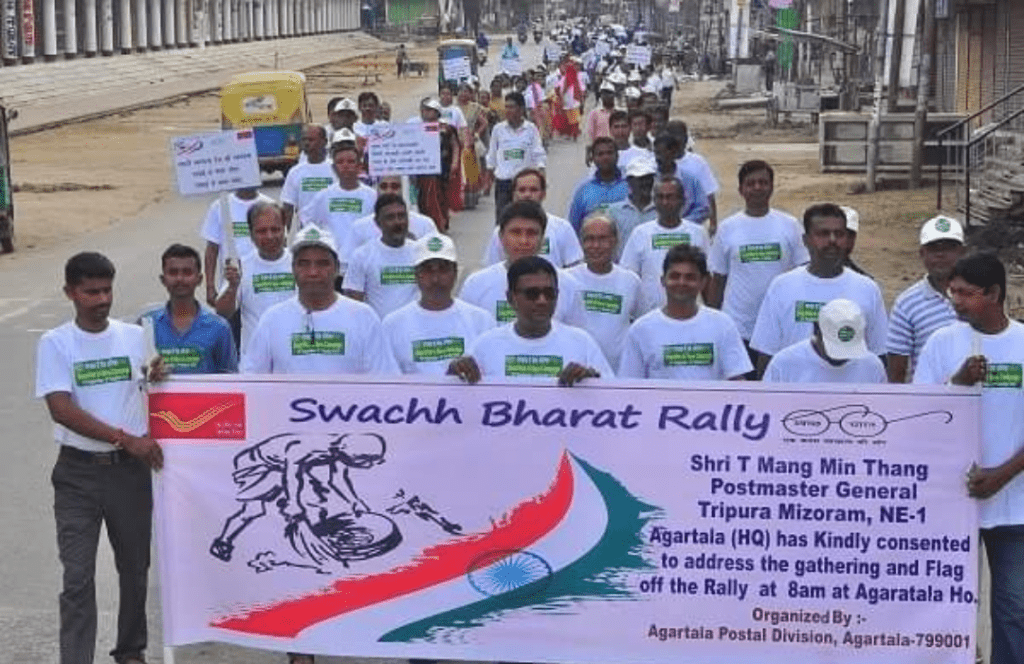- Education
- Updated on March 13, 2025
Swachh Bharat Abhiyan Essay in English for Students

The Swachh Bharat Abhiyan (Clean India Mission) is one of the most significant initiatives undertaken by the Government of India. Launched on October 2, 2014, by Prime Minister Narendra Modi, the mission aims to clean the streets, roads, and infrastructure of the cities, towns, and rural areas across India. This initiative seeks to improve the sanitation conditions of the country and raise awareness about the importance of cleanliness. In this essay, we will explore the mission’s importance, its goals, and its impact on the nation’s health and well-being, especially for students.
Introduction to Swachh Bharat Abhiyan
The Swachh Bharat Abhiyan was launched with a vision to achieve a cleaner, healthier, and more sustainable India. The mission aims to eradicate open defecation, promote waste management, and improve hygiene standards across the country. The vision behind this initiative is to create a clean and green India where every citizen is aware of the importance of sanitation.
One of the driving forces behind this mission is to make the country open-defecation free (ODF) by 2022. This includes the construction of toilets in every household, ensuring that sanitation becomes a priority for every Indian, irrespective of their geographical location. The mission’s impact is far-reaching, as it not only promotes cleanliness but also creates a sense of responsibility among the citizens.
Key Objectives of Swachh Bharat Abhiyan
The Swachh Bharat Abhiyan was not just about cleaning the streets, but also aimed to transform the way people perceive hygiene. Below are the key objectives of the mission:
1. Eradication of Open Defecation
One of the core objectives of Swachh Bharat Abhiyan is to eliminate open defecation. Open defecation is a severe issue in India, especially in rural areas, where sanitation facilities are often inadequate. The mission focuses on building toilets and encouraging people to use them, thereby preventing people from defecating in the open.
2. Waste Management
Proper waste management is another important focus of the mission. The program emphasizes segregating waste into biodegradable and non-biodegradable categories. It promotes recycling and proper disposal to prevent the accumulation of waste in public areas, which is one of the leading causes of pollution.
3. Creating Awareness
Swachh Bharat Abhiyan aims to raise awareness about the importance of sanitation, hygiene, and cleanliness. Public education campaigns help communities understand the need to adopt hygienic practices and make cleanliness a habit. Schools, colleges, and other institutions have played an important role in spreading awareness about sanitation.

4. Infrastructure Development
Another significant goal of the mission is to improve the existing sanitation infrastructure across the country. This includes constructing public toilets, improving waste disposal systems, and cleaning streets and drains. The government has allocated funds to improve these facilities, particularly in rural and underserved areas.
Role of Students in Swachh Bharat Abhiyan
Students play a vital role in the success of the Swachh Bharat Abhiyan. As the future leaders of the nation, they can set an example for others to follow. Their involvement can significantly contribute to making the mission a success. Here are a few ways in which students can contribute to this mission:
1. Spreading Awareness in Schools
Students can engage in awareness programs within their schools to educate their peers and teachers about the importance of cleanliness. They can organize cleanliness drives, create posters, and conduct awareness campaigns to inspire everyone to participate in the initiative.
2. Participation in Community Clean-Up Drives
Students can actively participate in community clean-up drives organized by local authorities or voluntary organizations. These drives could focus on cleaning parks, streets, markets, or even riverbanks. By participating in such activities, students help in spreading the message of cleanliness within their communities.
3. Practicing Cleanliness in Daily Life
It is crucial for students to practice cleanliness in their daily routines. Keeping their classrooms, homes, and surroundings clean can inspire others to do the same. Maintaining personal hygiene and encouraging others to do the same is a fundamental aspect of the mission.
4. Promoting Waste Segregation and Recycling
Students can also promote waste segregation in their schools and neighborhoods. Encouraging people to separate wet and dry waste and recycling plastic bottles, papers, and other materials can go a long way in reducing waste. Students can educate their families and friends about the importance of recycling and reusing products.
Achievements of Swachh Bharat Abhiyan
The Swachh Bharat Abhiyan has been successful in achieving several milestones since its launch. The following achievements demonstrate the success of the mission:
1. Significant Reduction in Open Defecation
One of the most notable achievements of the mission is the reduction in open defecation. According to reports, millions of toilets have been constructed across India, especially in rural areas, where the practice of open defecation was more prevalent. The government’s focus on providing sanitation facilities has improved the overall hygiene conditions.
2. Improved Sanitation Facilities in Rural Areas
Swachh Bharat Abhiyan has improved sanitation facilities in rural areas, which were previously underserved. The mission has also promoted hygiene practices, such as handwashing and safe waste disposal, which have contributed to better public health.
3. Cleanliness in Urban Areas
In urban areas, the mission has led to cleaner streets, better waste management practices, and more efficient garbage collection. Several cities have been recognized for their efforts to improve sanitation under the Swachh Bharat Mission rankings, motivating others to follow suit.
4. Ongoing Campaigns and Collaborations
The mission has garnered support from various sectors of society, including the government, private sector, and civil society. Multiple campaigns have been launched to keep the momentum going, with the involvement of celebrities, local leaders, and even international organizations.
Challenges Faced by Swachh Bharat Abhiyan
Despite its successes, Swachh Bharat Abhiyan faces several challenges that need to be addressed for the mission to reach its full potential.
1. Lack of Proper Infrastructure
In some areas, particularly remote and underdeveloped regions, the lack of basic infrastructure, such as toilets and waste disposal systems, remains a significant challenge. Though efforts are being made to address this issue, it is a long-term challenge that requires substantial investment and development.
2. Cultural Barriers
Cultural practices and beliefs in some regions of the country still contribute to a lack of awareness about hygiene and sanitation. Changing mindsets and behavior takes time and requires consistent efforts from all sectors of society.
3. Financial Constraints
Building the required infrastructure and running awareness campaigns in a country as large and diverse as India requires enormous financial resources. The government has made significant investments, but the financial strain on state and local bodies remains a challenge.
Conclusion
Swachh Bharat Abhiyan is a visionary initiative that aims to make India a cleaner and healthier country. While much has been achieved, the journey towards a cleaner India is ongoing. Students, as the future of the nation, play an important role in spreading awareness, practicing cleanliness, and participating in community-driven initiatives. By contributing to this mission, students not only help create a cleaner environment but also foster a sense of responsibility, pride, and unity in their communities. With continued efforts from all citizens, Swachh Bharat Abhiyan has the potential to transform India into a model of cleanliness and hygiene for the world to follow.
Also Read : New Year Resolution Essay for Students
Join the discussion
Related Articles
No results available
ResetTrending Articles


- Health
- Updated on July 16, 2025


- General
- Updated on July 16, 2025


- General
- Updated on July 14, 2025


- General
- Updated on July 12, 2025


- General
- Updated on July 12, 2025


- General
- Updated on July 8, 2025


- General
- Updated on July 7, 2025


- General
- Updated on July 8, 2025


- General
- Updated on July 4, 2025


- General
- Updated on July 2, 2025
No results available
Reset


